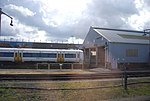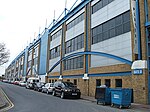Grange Redoubt
Forts in MedwayKent building and structure stubsRedoubts

Grange Redoubt, also known as one of the two Twydall Redoubts, was constructed in 1885. It was not included in the original list of defensive structures proposed by the Royal Commission on the Defence of the United Kingdom in 1860, but was conceived later and implemented as an experimental redoubt as opposed to a more substantial fort. Grange and Woodlands Redoubts defended Chatham Dockyard against landward attack from the east.
Excerpt from the Wikipedia article Grange Redoubt (License: CC BY-SA 3.0, Authors, Images).Grange Redoubt
Grange Road,
Geographical coordinates (GPS) Address Nearby Places Show on map
Geographical coordinates (GPS)
| Latitude | Longitude |
|---|---|
| N 51.3869 ° | E 0.5826 ° |
Address
Grange Road
Grange Road
ME7 2UW , Rainham Mark
England, United Kingdom
Open on Google Maps








